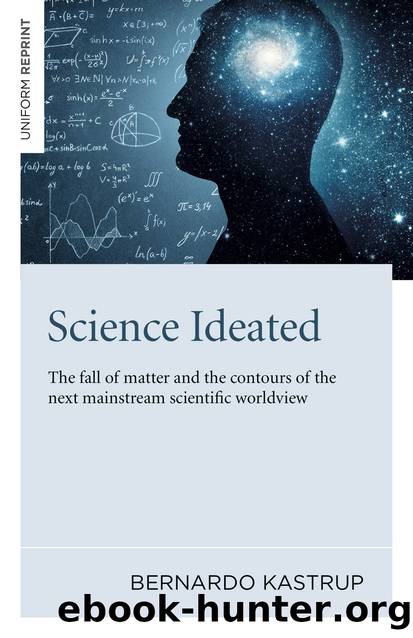Science Ideated: The Fall of Matter and the Contours of the Next Mainstream Scientific Worldview by Bernardo Kastrup

Author:Bernardo Kastrup [Kastrup, Bernardo]
Language: eng
Format: epub
Tags: Philosophy, Metaphysics, Science, General, Philosophy & Social Aspects
ISBN: 9781789046694
Google: d181EAAAQBAJ
Amazon: 1789046688
Publisher: Iff Books
Published: 2021-08-26T18:30:00+00:00
18.4 Synchronicity
Quantum predictions hold only at a statistical level. The outcomes of individual measurementsâthat is, individual observations or eventsâare non-deterministic and un predictable; quantum theory enforces no result whatsoever at the level of individual outcomes. It is this causally undetermined space that psychiatrist Carl Jung and Nobel Prize Laureate physicist Wolfgang Pauli populated with their notion of âsynchronicityâ: acausal meaningful coincidences that allegedly reflect archetypal patterns underlying not only the human psyche, but also the physical world at large (Jung 1985, Jung & Pauli 2001).
The authors denied âthat something about quantum theory may explain the serial coincidences that underlie synchronicityâ (Mroczkowski & Malozemoff 2019: 150). I believe this statement, although strictly correct, is misleading in that it sets up a straw man. The point is not that QM positively accounts for synchronicities; the point is thatâunlike classical physicsâQM leaves space open for synchronicities. Indeed, according to QM, at its most fundamental level nature is not deterministic; there is no causal necessity enforced at that level. This notion opens the door to other organizing principles still unknown to science.
The authors repeatedly argued that wave function collapse leads to random outcomes. But this seeming randomness does not contradict synchronicity either: regarding the latter, theorists have postulated that nature organizes itself according to global archetypal patterns. These global patterns can be easily reconciled with apparent randomness at the level of individual quantum events, as I illustrate with the following analogy.
Imagine that you toss three dice on a table, multiple times. After each toss, each individual die randomly displays a number from one to six. In other words, the behavior of each die is seemingly random from toss to toss. But now imagine that, when you look at all three dice together, after every toss, you realize that either they all display an even number or they all display an odd number. This is a simple hypothetical example of a global, synchronistic pattern that can occur even when the individual constituent events, considered in isolation, meet randomness criteria. In Jungâs words, âWithin the randomness of the throwing of the dice, a âpsychicâ orderedness comes into beingâ (Jung & Pauli 2001: 62).
If this kind of global synchronistic alignment were to happen across quantum events in the world at large, physicists would be none the wiser. For although they can test individual events in the laboratory and verify that, when taken in isolation, the events are random, they wouldnât be able to discern a global pattern within the complexity of the physical world at large; there are just too many âdiceâ to look at under controlled laboratory conditions.
The relationship between synchronicity and QM, which I articulated above, has been vouchsafed by Pauli himself. After reviewing the final draft of Jungâs synchronicity essay, Pauli wrote: âI ⦠found that ⦠from the standpoint of modern physics, [the essay] is now unassailableâ (Jung & Pauli 2001: 71).
Download
This site does not store any files on its server. We only index and link to content provided by other sites. Please contact the content providers to delete copyright contents if any and email us, we'll remove relevant links or contents immediately.
The remains of the day by Kazuo Ishiguro(8815)
Tools of Titans by Timothy Ferriss(8212)
Giovanni's Room by James Baldwin(7188)
The Black Swan by Nassim Nicholas Taleb(7009)
Inner Engineering: A Yogi's Guide to Joy by Sadhguru(6722)
The Way of Zen by Alan W. Watts(6504)
Asking the Right Questions: A Guide to Critical Thinking by M. Neil Browne & Stuart M. Keeley(5630)
The Power of Now: A Guide to Spiritual Enlightenment by Eckhart Tolle(5603)
The Six Wives Of Henry VIII (WOMEN IN HISTORY) by Fraser Antonia(5394)
Astrophysics for People in a Hurry by Neil DeGrasse Tyson(5130)
Housekeeping by Marilynne Robinson(4328)
12 Rules for Life by Jordan B. Peterson(4249)
Double Down (Diary of a Wimpy Kid Book 11) by Jeff Kinney(4204)
The Ethical Slut by Janet W. Hardy(4172)
Skin in the Game by Nassim Nicholas Taleb(4161)
Ikigai by Héctor García & Francesc Miralles(4123)
The Art of Happiness by The Dalai Lama(4063)
Skin in the Game: Hidden Asymmetries in Daily Life by Nassim Nicholas Taleb(3929)
Walking by Henry David Thoreau(3892)
